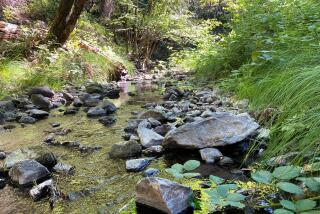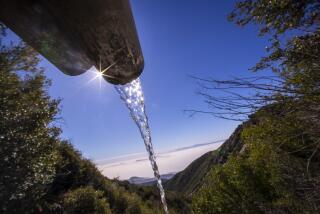District Can Still Tap Arrowhead
The battle over Lake Arrowhead water rights boiled down to dueling versions of arcane mountain history: whether the lake built a century ago was intended to be a reservoir for the valley below, or a swimming hole and water source for the local resort community.
The state Water Resources Control Board ruled Friday that the lake’s creators intended to provide drinking water for mountain residents, allowing the local water district to continue tapping the lake for its 7,800 customers, though under stricter limits.
The decision ends months of speculation over whether water rates would triple and that new construction at Lake Arrowhead would evaporate.
Still, residents will probably see some increase in water rates and a slowdown in the resort’s growth because the Lake Arrowhead water district will need to buy supplemental water and scour for ways to conserve and recycle, said the water district’s president.
“I am just ecstatic for the [water] rights, but by no means is it enough water to supply our community,” said Mary Ann Dickinson of the Lake Arrowhead Community Services District after the state board’s 3-0 vote.
The decision reverses the state board’s August ruling in a preliminary cease-and-desist order that nearly all of the water for Lake Arrowhead’s homes, shops and golf courses had been illegally drawn since 1978.
“That was really scary, bad news: They told us we couldn’t use our own lake,” said Lewis Murray, executive director of the Lake Arrowhead Communities Chamber of Commerce, who applauded Friday’s decision.
The state board ruled Friday that the district can siphon 1,566 acre-feet annually from Lake Arrowhead. One acre-foot of water supplies about two families for a year.
The district has until 2008 to reduce what it takes from the lake. In the meantime, it can’t draw more than 2,119 acre-feet annually, the amount it took last year.
The district also was fined $112,000 Friday for drawing more water than its rights allow and must submit periodic reports detailing conservation measures and reservoir status. The district won a significant concession when the state removed an edict that would have temporarily barred new water connections.
The district’s elected five-member board is expected to decide next week whether it wants to let Friday’s decision stand, appeal to the state board or take its case to court. Dickinson said the cost of litigation would be a factor.
While a team of attorneys for the state board supported the water board’s decision to reduce the amount of water the district taps, it worried about setting a precedent. The decision could allow recreational water-rights holders to use water for homes and businesses, skirting the permitting processes, the attorneys said in a letter to the state board. It may also put the onus on downstream water users and environmentalists to challenge how water is used, the letter said.
For similar reasons, the California Department of Fish and Game told the state board that the order could make it more difficult to safeguard fish and wildlife harmed by a change in water use.
The state board began an investigation in 2003 after the Arrowhead Lake Assn., a property owners group that regulates lake recreation, and Ted Heyck, a resident who later was elected to the water district board, filed complaints against the district.
Worried that the siphoning, combined with years of drought, had reduced lake levels, they contended that the district had no right to take from the lake.
An August order from the state board backed their criticisms, though it said swimmers and boaters could still use Lake Arrowhead, which holds about 47,000 acre-feet. Water use in the San Bernardino Mountains had also harmed downstream water-rights holders on the Mojave River, said the state board’s order.
State officials suggested that the district purchase water from another agency, more stringently conserve water or tap other supplies, such as ground wells.
The district, whose key supplier is Lake Arrowhead, quickly challenged that ruling, predicting disaster for consumers if it were upheld.
In November evidentiary hearings, attorneys on both sides argued for their version of Lake Arrowhead’s pre-1914 history. The state allows a claim to water rights without a permit if they were established before that year, when the state’s water commission was formed.
The district told the story of a lake intended for drinking water and bathing, while the state said builders wanted to pump the water to the valley, a plan later abandoned.
Both sides tried to forge a compromise, but a breakdown in negotiations resulted in Friday’s hearing before the water board, a division of the state Environmental Protection Agency, in Sacramento.
More to Read
Sign up for Essential California
The most important California stories and recommendations in your inbox every morning.
You may occasionally receive promotional content from the Los Angeles Times.










